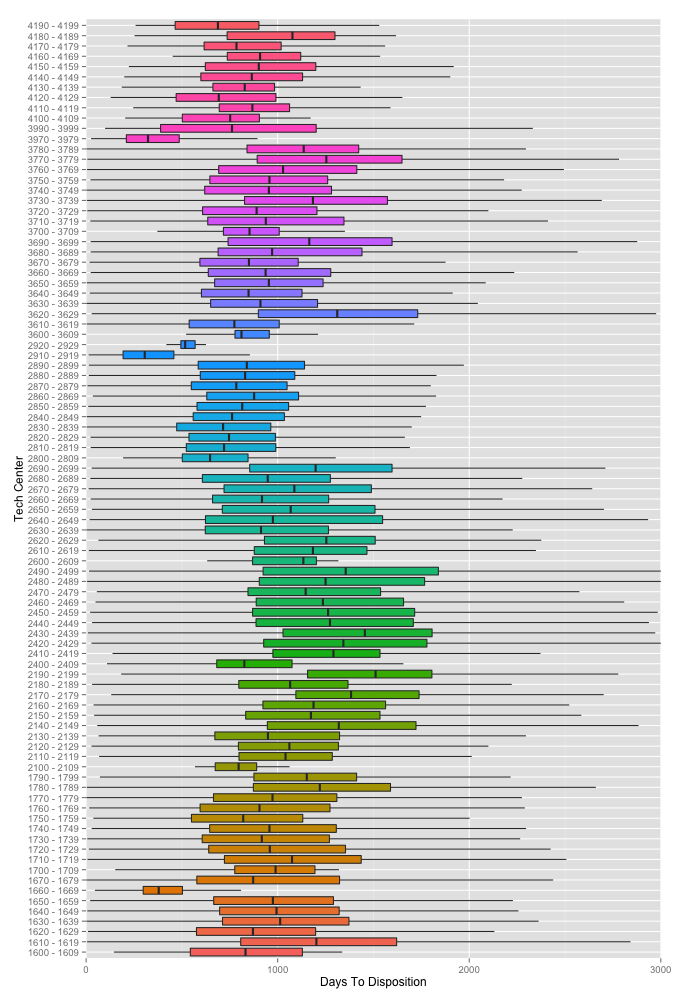 “Time is money” rings especially true for those pursuing patents at the USPTO. Anyone who has previously dealt with this organization can attest to the fact that it is slow moving and extremely costly. Being that this single government entity is charged with processing upwards of 600,000 patent applications per year, the speed at which it operates is unsurprising. However, what is surprising is the substantial variance in speed at which each technology center and individual art unit operates. Here at Juristat we like to turn data into insight. We believe that being able to predict the amount of time to disposition equips prosecutors and applicants with the information needed to manage expectations, properly allocate resources, and develop the strongest application strategies.
“Time is money” rings especially true for those pursuing patents at the USPTO. Anyone who has previously dealt with this organization can attest to the fact that it is slow moving and extremely costly. Being that this single government entity is charged with processing upwards of 600,000 patent applications per year, the speed at which it operates is unsurprising. However, what is surprising is the substantial variance in speed at which each technology center and individual art unit operates. Here at Juristat we like to turn data into insight. We believe that being able to predict the amount of time to disposition equips prosecutors and applicants with the information needed to manage expectations, properly allocate resources, and develop the strongest application strategies.
For each chart presented in this article, the horizontal lines show the data set for the technology center or art unit indicated. The far left point on that horizontal line is the quickest time to disposition outlier while the far right is the slowest outlier. It is important to note that these outliers are extremely quick or slow to disposition due to various factors. The minimum outliers are typically continuations of applications that have already been granted, while the maximum outliers usually involve foreign priority applications that have filing dates long before the prosecution began in earnest. The colored box along each line contains and highlights the middle half of the data. The dark vertical line contained in each colored box shows the median.
When broken down by technology center, it is easy to observe the differences in days to disposition. Technology center 2900, at the bottom of the chart below, has the quickest average time to disposition while technology center 2400 has the slowest.
Working from the bottom of the chart upwards, it is relatively easy to understand why some technology centers are quicker to disposition than others. The technology centers with the shortest average times to disposition, 2900 (Designs) and 3900 (Central Reexamination Unit), are unsurprising in that they operate differently than the other utility patent-based technology centers. Design patents are notoriously easier to obtain and therefore likely face fewer hurdles to allowance, thereby permitting this technology center to operate extremely quickly. Likewise, reexamination is an entirely different process than pursuing a utility patent and therefore moves at a different pace. The fundamental differences in these two technology centers help to explain their speed.
Another interesting technology center to note is 4100, often referred to as the “Patent Training Academy.” The relatively quick speed at which this technology center operates could have several contributing factors. For instance, because it’s used for training, it’s possible that only relatively simple applications are assigned to the 4100s. Moreover, the assistance provided to the trainees may also speed up the process.
As for the slower moving technology centers, 2400 (Network, Multiplexing, Cable & Security), 2600 (Communications), and 2100 (Computer Architecture, Software & Information Security), the slow-moving tendency is likely explained by those technology centers largely dealing with software and computer-based patents. These types of patents are the source of much recent controversy due to their often-criticized lack of clarity. In fact, applications filed in these three technology centers (as well as those filed that fall into the business methods realm of technology center 3600) qualified for the recently concluded “Glossary Pilot Program” aimed at enhancing claim clarity. The structure and content of applications filed in those technology centers are likely the reason for their longer average times to disposition.
If you consistently file applications in the same technology center or a handful of technology centers, it may be more beneficial to view this information broken down even further into individual art units.
Being that there is variance within technology centers, viewing the information broken down in this way allows you to visualize where an individual art unit falls in regards to days to disposition. This allows you to further tailor and optimize your prosecution strategies depending on the specific art unit assigned. For example, while we know from the previous chart that technology center 2900 has the quickest average time to disposition, here a substantial difference is observed between art units 2910-2919 and art units 2920-2929.
Also worth noting is that, although technology center 2400 boasts the average slowest time to disposition, it is in fact individual art units 2190-2199 that have the slowest overall rate.
Overall, insight into specific technology centers or art units is beneficial in formulating strong prosecution strategies. Hopefully, by knowing the average time to disposition, applicants will be able to most efficiently utilize resources as well as manage time and expectations. Additionally, it is important to note that, due to the rapidly changing law and policy in several of these art units, we expect these timing averages to change as well. Monitoring the speed at which things are moving in the USPTO could prove highly beneficial when prosecuting future applications.

![[IPWatchdog Logo]](https://ipwatchdog.com/wp-content/themes/IPWatchdog%20-%202023/assets/images/temp/logo-small@2x.png)



![[Advertisement]](https://ipwatchdog.com/wp-content/uploads/2024/04/UnitedLex-May-2-2024-sidebar-700x500-1.jpg)
![[Advertisement]](https://ipwatchdog.com/wp-content/uploads/2024/04/Artificial-Intelligence-2024-REPLAY-sidebar-700x500-corrected.jpg)
![[Advertisement]](https://ipwatchdog.com/wp-content/uploads/2024/04/Patent-Litigation-Masters-2024-sidebar-700x500-1.jpg)

![[Advertisement]](https://ipwatchdog.com/wp-content/uploads/2021/12/WEBINAR-336-x-280-px.png)
![[Advertisement]](https://ipwatchdog.com/wp-content/uploads/2021/12/2021-Patent-Practice-on-Demand-recorded-Feb-2021-336-x-280.jpg)
![[Advertisement]](https://ipwatchdog.com/wp-content/uploads/2021/12/Ad-4-The-Invent-Patent-System™.png)






Join the Discussion
2 comments so far.
Alex
June 26, 2015 09:12 amSTH is partially right. Express abandonments and first action allowances should be overrepresented in 4100’s disposals. Additionally, there can be no long RCE prosecution times. But there’s also the fact that any amendments are sent to a nearly empty docket, substantially reducing the processing time for a rejected application that contains allowable subject matter.
This analysis is poor representation for juristat.
STH
June 25, 2015 11:49 pmThe skew for 4100 is because examiners only spend 4–6 months in that TC before being transfered to their “normal” TC. So the only cases that get credited as TC4100 final dispositions are those that reach final disposition within 6 months—and usually less—of the examiner picking it up: first action allowances and express abandonments are pretty much it. That’s why the numbers are skewed low.